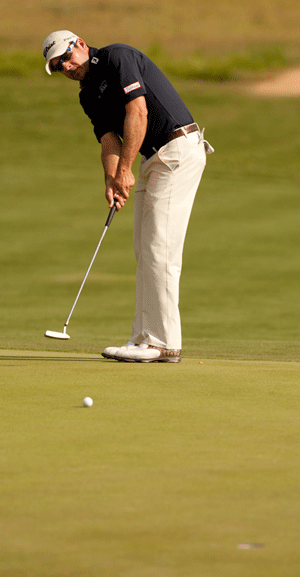The Loop
How He Made That: Ben Curtis' putts that mattered
*Editor's Note: Every Monday Kevin Hinton, Director of Instruction at Piping Rock Club in Locust Valley, N.Y. and one of Golf Digest's Best Young Teachers, tells you how a tour player hits a key shot. This week, Kevin looks at the two long putts Ben Curtis made to win the Valero Texas Open on Sunday, and gives you some tips to improve your long-putting. *
*Roger Schiffman
Managing Editor
Golf Digest
Twitter: @RogerSchiffman*
By Kevin Hinton
Ben Curtis' ability to make some important long putts down the stretch at the Texas Open was key to his victory yesterday. Curtis made a 25-footer on the 17th hole to save par, as well as 12-footer for birdie on the 18th hole to win by two strokes. Ben is currently ranked second on the PGA Tour in the statistical category of Strokes Gained, and he is yet to three-putt in a tour event this year. Here are three ideas that will help you make a few more long putts.

1. __Practice your four-footers
__If you want to make more long putts, get better at your short putts! One reason the average golfer makes so few longer putts is they are putting scared and often come up short. We've all heard the saying that "100 percent of putts left short don't go in," but it still rings true. (Hubert Green infamously said "97 percent...") But you'll never make it if the ball doesn't get to the hole. It's the fear of the come-back putt that can make us come up short on the first putt. If you spend a lot of time practicing your three- to five-footers, you'll feel much more confident in actually giving that first putt a chance to go in. The other advantage of hitting your first putt with enough pace is that if it doesn't go in, you'll see the break for your next putt. Knowing the break will definitely decrease your number of three-putts.
__2. Make center contact
__To make a putt of any significant length, you need to do a combination of things correctly. You must have the correct read, start the ball on your intended line, and hit the ball with the correct speed. If you don't do all of these things, consistently making a decent number of long putts is essentially impossible. None of this works without making center contact on the putterface at impact. Off-center hits cause the face to open or close, as well as affect the distance the ball travels. You can make a stroke of the perfect size and pace for a 20-footer, but the ball will only go 20 feet if you make center contact. A simple drill would be to use two tees to form a gate that is only slightly bigger than the head of your putter. Then hit putts from within the gate, being sure to miss the tees. Typically, the most common cause of off-center hits is excessive movement of your legs or head. The stiller you can stay in putting the better.
__
3.__ Read the green smartly
Becoming a proficient green reader is definitely an acquired skill that takes time and experience. However, here are a few ideas that can help. When you walk onto a green, simply
try to determine if the entire green, or at least the section you are putting from, is a back-to-front sloping green or vice versa. More greens are pitched from back to front. If you have a putt of any significant length, you always know the ball will break in the direction of the low part of the green, even if there are more subtle breaks inbetween. Another point to be aware of is that you should always pay much more attention to the slope around the hole than you do in the earlier part of the putt. The ball is traveling much slower as it approaches the hole, thus the slope around the cup has a much greater influence on the ball. Slope early in the putt has very little effect because the ball is rolling at a much faster pace. Finally, a good skill to develop on the greens is the ability to establish where the "straight" putt is around the hole. If you get good at finding the straight putt (there are most likely two, on opposites sides of the hole to each other), where your ball lies in proximity to the straight putt will help you ascertain how much your ball is breaking. Phil Mickelson's pre-putt routine used to be to first make a practice stroke at the straight putt, regardless of where his ball was. Then, gauging how far his ball was from the straight putt helped him determine how much break to play. This takes a little practice, but the better you get at ascertaining where a putt is straight, the more you'll know about the putt you're about to hit.